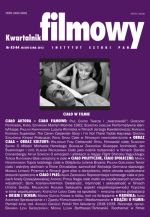Giuseppe Arcimboldi i Jan Švankmajer. Od gabinetów sztuki i osobliwości do kolekcji filmów jako zbioru dzieł osobliwych
Giuseppe Arcimboldi, Jan Švankmajer and others. From cabinets of art and curiosities to a collection of films as a set of singular works
Author(s): Bogusław ZmudzińskiSubject(s): Theatre, Dance, Performing Arts
Published by: Instytut Sztuki Polskiej Akademii Nauk
Keywords: Arcimboldi Giuseppe; Švankmajer Jan
Summary/Abstract: In the article an attempt is made to adapt the modern idea of a cabinet of art and curiosities to the need of locating the achievements of art cinema in the context of a widely understood cultural tradition. Parallel to the relation between the phenomenon of still life paintings and the film phenomenon of object animation, Zmudziński discovers connections between the idea of a cabinet of art and curiosities in the work of mannerist Giuseppe Arcimboldi, in the context of a collector’s passion of the emperor Rudolf the 2 nd , and the way this idea functioned in the work of the surrealist Jan Švankmajer, in the context of contemporary collections of curios. The author relies on two important, yet culturally and historically very different examples, to make his argument, namely the fate of the relics of St. Louis the 9 th , King of France and the exhibition activities of the controversial anatomist and plastinator Dr. Gunther von Hagens. In his interpretation of the works of Arcimboldi and Švankmajer, the author builds a model of five levels of functioning of the concept of curio in the works of both artists. The starting point of this model is the adoption of so called objective interpretation when considering the relationship between humans and reality. In conclusion, the author argues that the central area of contemporary film collection of curiosities is filled with on the one hand animated films made with the object animation technique, and on the other hand feature films with peculiar protagonists who lose their subjectivity (and thus also their freedom), becoming puppets in the hands of fate, powerful and independent forces, or – at the most drastic – other people.
Journal: Kwartalnik Filmowy
- Issue Year: 2013
- Issue No: 83-84
- Page Range: 163-178
- Page Count: 16
- Language: Polish

